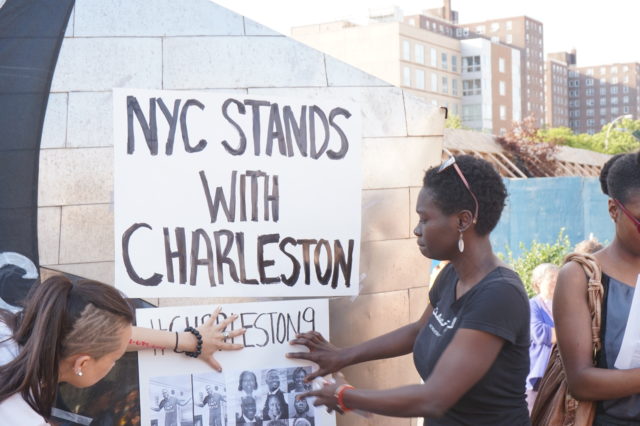
Lone Wolves are born in packs
Since its beginnings, racist violence has been a tool used by white nationalists and white supremacists in the US. Perpetrators of this violence understand it intimidates, coerces and terrorizes. They use it to send a clear message of who has the right to be here and whose values will prevail.
by Terri A. Johnson, Executive Director, Center for New Community, Chicago
In September, 1963, four members of the Ku Klux Klan, founded after the Civil War, planted at least 15 sticks of dynamite at the 16th Street Baptist Church in Birmingham, Alabama. When detonated, four 14 year old girls – Addie Mae Collins, Carol Denise McNair, Carole Robertson and Cynthia Wesley – were killed and 22 others injured. This was the fourth bombing in as many weeks.
Fifty two years later, in June, 2015 Dylann Roof walked into another church, Mother Emanuel AME Church in Charleston, South Carolina. He sat in a bible study class for nearly one hour and then shot and killed nine people – Cynthia Hurd, Susie Jackson, Ethel Lance, Rev. DePayne Middleton-Doctor, Hon. Rev. Clementa Pinckney, Tywanza Sanders, Rev. Daniel Simmons Sr., Rev. Sharonda Singleton, and Myra Thompson. Roof, unlike the men who bombed the 16th Street Baptist Church, was not a member of the Ku Klux Klan or any other hate group. He was a 21 year old Southerner without the benefit of years of being told his whiteness made him superior, unlike Robert Chambliss, (the first man convicted for the 16th Street Baptist Church in 1977), who was 59 in 1963. He acted alone. He was a »lone wolf« – a term with many interpretations.
The simplest definition refers to someone who plans and executes a violent act by themselves, not as part of a larger organization or movement. Another definition includes members of groups who have been indoctrinated but act alone. Others describe people who act violently with no political or ideological motivation. The modern concept is linked to a »leaderless resistance« strategy promoted by white nationalists. In 1987, 14 visible national leaders, associated with the 1983 Aryan World Congress, were charged with conspiracy to overthrow the US government. One of them, Louis Beam republished an essay calling for a »leaderless resistance«, which would make getting caught harder. Other proponents include white nationalists Alex Curtis and Tom Metzger, who writes in his essay, »Laws for the Lone Wolf« all involvement with membership groups should be avoided.
The label, when used to describe Roof may be accurate, but it is incomplete. Despite the fact Roof was not a member of a group, he identified with organized racist groups, confessing his actions were designed to create a race war. On his website, the lastrhodesian.com, there were photos of Roof surrounded with Confederate flags and Nazi swastikas, along with a manifesto, where he shared his ideas toward people of color. During his trial he wore shoes decorated with neo-Nazi codes and Klan runes. He wrote about his discovery of white supremacist views after he googled »black on white crime« and found a website of the Council of Conservative Citizens, which while founded in the 1980s is a descendent of the White Citizens Councils of the Civil Rights era, whose members supported segregation and pledged to end race mixing. He spent time reading the Daily Stormer, a neo-Nazi website.
He wrote about acting alone. »I am not in the position to, alone, go into the ghetto and fight. I chose Charleston because it is the most historic city in my state, and at one time had the highest ratio of blacks to Whites in the country. We have no skinheads, no real KKK, no one doing anything but talking on the Internet. Well someone has to have the bravery to take it to the real world, and I guess that has to be me.« Dylann Roof may never have walked into a meeting, participated in a rally or received a membership card, but he did walk into a virtual world of hate and learned its lessons well. He acted alone, but not outside of a larger system. His story provides insight for those working to end racist violence.
Internet as a weapon
The US Far Right has killed nearly 450 people since 1990. For the past 15 years, individuals and small groups have been responsible for the majority of those acts. It makes to use the lone wolf paradigm to understand what is happening. There are, however, problems with the paradigm. First, the term has so many different definitions and uses, it has lost clarity as a label. The direct link to a white supremacist strategy to advance their movement, may mean we need a different term. Second, the term may have be irrelevant at this point of the Internet age. The Internet has redefined the ways to education and mobilize people for causes and issues. For years, Far Right extremists, like everyone else, met face to face to spread their message of hate and violence. The Internet provides limited exposure and access to a bigger pool of potential supporters. Like other organizations, they moved their activities online.
If we only consider the fact that the perpetrator acted alone or was »self-radicalized«, our analysis is flawed. We overlook the pervasive culture of racial animus and division that breeds this violence.
Unlike other organizations, they weaponized the Internet. Third, and most dangerously, the lone wolf paradigm disconnects the violent actor from a larger cultural context, creating deeper challenges for the work. If we only consider the fact that the perpetrator acted alone or was »self-radicalized«, our analysis is flawed. We overlook the pervasive culture of racial animus and division that breeds this violence. We call them »crazies« acting on their own opinions toward their own ends. We linger on the intentions of the lone perpetrator – was it hate? ignorance? anger? pure racism? –ignoring the reality that white nationalism is a strategic and coordinated movement with a political agenda, not one born of emotions.
We pretend this racist violence is not part of a historical political structure of white violence against African Americans and other people of color. We mis- diagnose the problem as one of individual acts, not systemic patterns; patterns connecting many people in their beliefs, if not their actions. Roof’s racist ideas are not new, nor are they necessarily marginal. Many people, most of whom are not in hate groups, believe some of these ideas. We have to acknowledge these ideas may be extreme, but, sadly, are not fringe. Roof, as murderer is an outlier, but Roof as one of the people increasingly drawn to white nationalism, is not.
The number of hate groups has grown since 2000 and there has been an increase in hate incidents and hate crimes throughout the country. In August of this year, the world watched as the »Unite the Right« demonstration took over the streets of Charlottesville, Virginia. It was the largest white nationalist rally since 1987 and it ended in another violent tragedy when Heather Heyer was killed and many others hurt.
White supremacist groups are not causing racism, they are exploiting it. Work to defeat these groups has be designed to deal with both the individual actors and the larger systems and culture that create and sustain them – lone wolves are born and bred in packs. They are working hard to advance a vision of the world that is shared by a growing number of people. And we, committed to ending this violence, must work as hard. In the worlds of Ella Baker, civil and human rights activist, »we who believe in freedom cannot rest«. If we want to end racist violence, we must unite for justice, continue to expose the architects of the contemporary white nationalist movements, protect those under attack and advance our vision of a world where ALL of humanity thrives.


